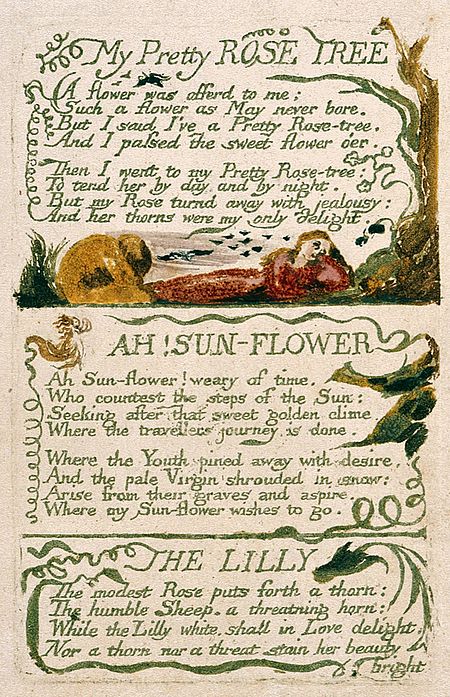
"The Lilly" is a poem written by the English poet William Blake. It was published as part of his collection Songs of Experience in 1794.

"The Lilly" is a poem written by the English poet William Blake. It was published as part of his collection Songs of Experience in 1794.
The Rose, which is a symbol of love and beauty, puts forth a flaw or a thorn. The humble sheep also calls to attention its horn or flaw. The Lilly, however, which is pure and white, enjoys love and has no thorn or flaw to show the world.
According to Antal, Blake's Flower Plate is composed of three flower poems on the same plate for a reason: to illustrate three types of love; Poetic Love, Earthly Love, and Human Love. The Lilly deals with the "Poetic Love" concept of this "threefold vision of love". [3] This is considered the "Poetic Love" because the Lilly is innocent, and pure, and unable to be besmirched by love or by thorns. As Johnson states, "Oddly enough, most emblem designs featuring lilies show the flower surrounded by thorns." [4] Blake's Lilly has no thorns. Unlike the sheep or the Rose, the Lilly is the purest of them all. This echoes poetic love as ideally, love should be flawless. Love should be perfect and everything that people dream of. Even though the two lovers themselves may have flaws, love itself shouldn't have any.
Though a rather short poem, and for that matter, the shortest poem on the page, "The Lilly" puts forth a great deal of symbolism and figurative language to be interpreted in numerous ways. Though there are many different interpretations out there, the experts seem to agree on two main themes for this poem. The two main themes within this poem are Purity and the Ideal Love.
Though Purity is often immediately compared with virginity, some critics argue that The Lilly maintains a rather different kind of purity. Johnson quotes, "The text and design of 'The Lilly' emblematize and celebrate a fresh conception of purity, the purity of gratified desire. To be unstained by thorns is to allow the 'stain' of personal contact, which is the only true whiteness." This purity is not virginity; rather, this purity is knowing what you want and never settling until you get what you desire. You don't alter your desires or ambition despite the circumstances, but keep true to what you truly desire. Instead of allowing the thorns of "personal contact" or attempts at intervention that third parties may have tried to force on her, the Lilly maintains her resolve and stays true to what she knows she desires. Antal captures this idea well when she says "The Lilly, is the most spiritual showing that 'however subject the natural body might be to force and threats, man's spiritual body, like the Lilly, could never be essentially debased'". [3]
The idea of Purity in the poem also trickles into the other theme of Ideal Love. The Ideal Love is often the purest form of love in that the love is pure because it is pure love; there is no game, or flaws to it. The Ideal Love is simply love, purely innocent and true love. Johnson states that "The Lilly who delights in love is another manifestation of the 'sweet flower' offered to the Rose lover in the first poem on his plate." Rather than denying perhaps the true, ideal love, as the man in "My Pretty Rose Tree" does, "The Lilly" vows to delight itself in a pure and true love not besmirched by duty, or any other thorn the rose may bear.

William Blake was an English poet, painter, and printmaker. Largely unrecognised during his life, Blake is now considered a seminal figure in the history of the poetry and visual art of the Romantic Age. What he called his “prophetic works” were said by 20th-century critic Northrop Frye to form "what is in proportion to its merits the least read body of poetry in the English language". His visual artistry led 21st-century critic Jonathan Jones to proclaim him "far and away the greatest artist Britain has ever produced". In 2002, Blake was placed at number 38 in the BBC's poll of the 100 Greatest Britons. While he lived in London his entire life, except for three years spent in Felpham, he produced a diverse and symbolically rich collection of works, which embraced the imagination as "the body of God" or "human existence itself".

The Marriage of Heaven and Hell is a book by the English poet and printmaker William Blake. It is a series of texts written in imitation of biblical prophecy but expressing Blake's own intensely personal Romantic and revolutionary beliefs. Like his other books, it was published as printed sheets from etched plates containing prose, poetry, and illustrations. The plates were then coloured by Blake and his wife Catherine.

Floriography is a means of cryptological communication through the use or arrangement of flowers. Meaning has been attributed to flowers for thousands of years, and some form of floriography has been practiced in traditional cultures throughout Europe, Asia, and Africa. Plants and flowers are used as symbols in the Hebrew Bible, particularly of love and lovers in the Song of Songs, as an emblem for the Israelite people, and for the coming Messiah. In Western culture, William Shakespeare ascribed emblematic meanings to flowers, especially in Hamlet.

Songs of Innocence and of Experience is a collection of illustrated poems by William Blake. It appeared in two phases: a few first copies were printed and illuminated by Blake himself in 1789; five years later, he bound these poems with a set of new poems in a volume titled Songs of Innocence and of Experience Shewing the Two Contrary States of the Human Soul. Blake was also a painter before the creation of Songs of Innocence and Experience and had painted such subjects as Oberon, Titania, and Puck dancing with fairies.
Amon George Liner was an American poet and playwright.
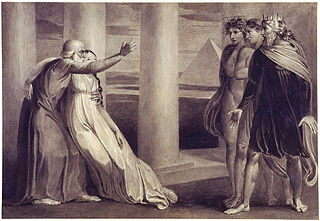
Tiriel is a narrative poem by William Blake, written c.1789. Considered the first of his prophetic books, it is also the first poem in which Blake used free septenaries, which he would go on to use in much of his later verse. Tiriel was unpublished during Blake's lifetime and remained so until 1874, when it appeared in William Michael Rossetti's Poetical Works of William Blake. Although Blake did not engrave the poem, he did make twelve sepia drawings to accompany the rough and unfinished manuscript, although three of them are considered lost as they have not been traced since 1863.
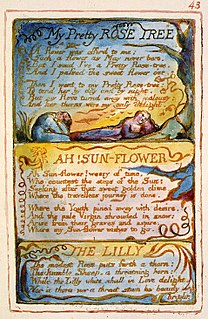
"Ah! Sun-flower" is an illustrated poem written by the English poet, painter and printmaker William Blake. It was published as part of his collection Songs of Experience in 1794. It is one of only four poems in Songs of Experience not found in the "Notebook".
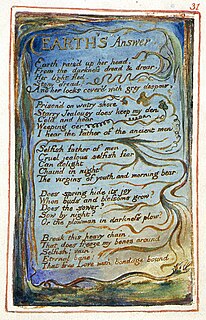
Earth's Answer is a poem by William Blake within his larger collection called Songs of Innocence and of Experience. It is the response to the previous poem in The Songs of Experience-- Introduction . In the Introduction, the bard asks the Earth to wake up and claim ownership. In this poem, the feminine Earth responds.

My Pretty Rose Tree is a poem written by the English poet William Blake. It was published as part of his collection Songs of Experience in 1794.

The Mental Traveller is a poem by William Blake. It is part of a collection of unpublished works called The Pickering Manuscript and was written in a manner that suggests the poem was to be read directly from the collection.

Poetical Sketches is the first collection of poetry and prose by William Blake, written between 1769 and 1777. Forty copies were printed in 1783 with the help of Blake's friends, the artist John Flaxman and the Reverend Anthony Stephen Mathew, at the request of his wife Harriet Mathew. The book was never published for the public, with copies instead given as gifts to friends of the author and other interested parties. Of the forty copies, fourteen were accounted for at the time of Geoffrey Keynes' census in 1921. A further eight copies had been discovered by the time of Keynes' The Complete Writings of William Blake in 1957. In March 2011, a previously unrecorded copy was sold at auction in London for £72,000.
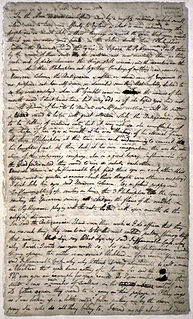
An Island in the Moon is the name generally assigned to an untitled, unfinished prose satire by William Blake, written in late 1784. Containing early versions of three poems later included in Songs of Innocence (1789) and satirising the "contrived and empty productions of the contemporary culture", An Island demonstrates Blake's increasing dissatisfaction with convention and his developing interest in prophetic modes of expression. Referred to by William Butler Yeats and E. J. Ellis as "Blake's first true symbolic book," it also includes a partial description of Blake's soon-to-be-realised method of illuminated printing. The piece was unpublished during Blake's lifetime, and survives only in a single manuscript copy, residing in the Fitzwilliam Museum, in the University of Cambridge.

All Religions are One is a series of philosophical aphorisms by William Blake, written in 1788. Following on from his initial experiments with relief etching in the non-textual The Approach of Doom (1787), All Religions are One and There is No Natural Religion represent Blake's first successful attempt to combine image and text via relief etching, and are thus the earliest of his illuminated manuscripts. As such, they serve as a significant milestone in Blake's career; as Peter Ackroyd points out, "his newly invented form now changed the nature of his expression. It had enlarged his range; with relief etching, the words inscribed like those of God upon the tables of law, Blake could acquire a new role."

There is No Natural Religion is a series of philosophical aphorisms by William Blake, written in 1788. Following on from his initial experiments with relief etching in the non-textual The Approach of Doom (1787), All Religions are One and There is No Natural Religion represent Blake's first successful attempt to combine image and text via relief etching, and are thus the earliest of his illuminated manuscripts. As such, they serve as a significant milestone in Blake's career; as Peter Ackroyd points out, "his newly invented form now changed the nature of his expression. It had enlarged his range; with relief etching, the words inscribed like those of God upon the tables of law, Blake could acquire a new role."
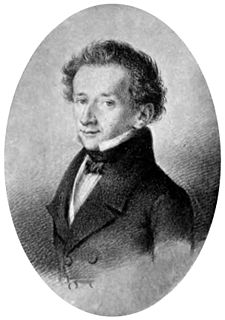
Canti is a collection of poems by Giacomo Leopardi written in 1835. The Canti is generally considered one of the most significant works of Italian poetry.
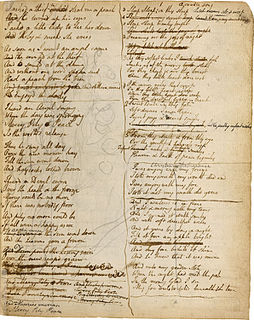
The Notebook of William Blake was used by William Blake as a commonplace book from c. 1787 to 1818.
In William Blake's mythology, Beulah, originally Hebrew בְּעוּלָה, is "the realm of the Subconscious, the source of poetic inspiration and of dreams." It is also, according to Blake scholar Alexander S. Gourlay, "a dreamy paradise where the sexes, though divided, blissfully converse in shameless selflessness. Beulah is available through dreams and visions to those in Ulro, the utterly fallen world." Between Eternity and Ulro, it is imagined as a place without conflict similar to a conventional image of heaven or Eternity. However, for Blake, the idea of an everlasting peaceful Eternity is misguided and fallen.
"Night" is a poem in the illuminated 1789 collection Songs of Innocence by William Blake, later incorporated into the larger compilation Songs of Innocence and of Experience. "Night" speaks about the coming of evil when darkness arrives, as angels protect and keep the sheep from the impending dangers.

"The School Boy" is a 1789 poem by William Blake and published as a part of his poetry collection entitled Songs of Experience. These poems were later added with Blake's Songs of Innocence to create the entire collection entitled "Songs of Innocence and of Experience Shewing the Two Contrary States of the Human Soul". This collection included poems such as "The Tyger", "The Little Boy Lost", "Infant Joy" and "The Shepherd". These poems are illustrated with colorful artwork created by Blake first in 1789. The first printing in 1789 consisted of sixteen copies. None of the copies of Songs of Innocence are exactly alike as some of them are incomplete or were colored in posthumously "in imitation of" other copies.

Rosa Mystica or Mystical Rose is a poetic title of Mary. One form of Marian devotion is invoking Mary's prayers by calling upon her using a litany of diverse titles, and the title 'Mystical Rose' is found in the Litany of Loreto. Since 1947, the title has also been associated with a form of devotion promoted in Italy by alleged visionary Pierina Gilli.